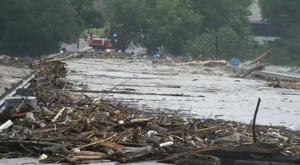At least six people have lost their lives, and 20 more remain unaccounted for after unprecedented flash floods swept through the Texas Hill Country. The deluge, which occurred overnight, was the result of months’ worth of rain falling in just a few hours, severely impacting Kerr County as the Guadalupe River overflowed its banks.
Rescue teams have been deployed across the region, working tirelessly to locate missing individuals and provide aid to those affected. The National Weather Service had issued multiple warnings, but the sheer volume of rain overwhelmed local infrastructure, leading to catastrophic flooding.
Unprecedented Rainfall and Its Immediate Impact
The flash floods were triggered by an intense storm system that dumped over a foot of rain in some areas. This sudden influx caused the Guadalupe River to rise rapidly, inundating homes, roads, and businesses. Emergency services have been stretched thin as they respond to calls from stranded residents.
A spokesperson for the Texas Department of Public Safety described the situation as “one of the most severe flooding events in recent memory.” The agency has urged residents to remain vigilant and heed evacuation orders as more rain is forecasted in the coming days.
Historical Context and Expert Insights
Flash floods are not uncommon in Texas, but the severity of this event has drawn comparisons to past disasters. In 2015, similar floods in the region resulted in significant loss of life and property damage. Experts attribute the increasing frequency and intensity of such events to climate change, which is altering weather patterns globally.
“The Hill Country is particularly vulnerable due to its topography and the rapid development in the area,” said Dr. Jane Thompson, a climatologist at the University of Texas. “As urban areas expand, natural water absorption is reduced, exacerbating flood risks.”
Dr. Thompson’s analysis highlights the need for improved urban planning and infrastructure investment to mitigate future risks. Local governments are now faced with the challenge of balancing growth with environmental sustainability.
Community Response and Recovery Efforts
In the wake of the disaster, community members have rallied together to support those affected. Shelters have been set up in nearby towns, providing food, clothing, and temporary housing for displaced families. Volunteers from across the state have joined in the relief efforts, offering their time and resources to assist in recovery operations.
Meanwhile, state and federal agencies are coordinating to assess the damage and allocate funds for rebuilding. Governor Greg Abbott has declared a state of emergency, unlocking resources to aid in the recovery process.
“Texans are known for their resilience,” Governor Abbott stated. “We will rebuild and come back stronger, but we must also learn from this tragedy to prevent future occurrences.”
Looking Ahead: Prevention and Preparedness
The recent floods underscore the urgent need for enhanced flood prevention and preparedness measures. Experts advocate for the development of comprehensive water management strategies, including improved forecasting systems and infrastructure upgrades.
Local officials are also considering stricter building codes and land-use policies to minimize future risks. As the climate crisis continues to unfold, the importance of proactive measures cannot be overstated.
As the region begins the long road to recovery, the focus will remain on ensuring the safety and well-being of its residents. The lessons learned from this disaster will hopefully guide future efforts to protect communities from the devastating impacts of extreme weather events.
